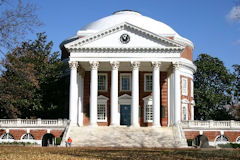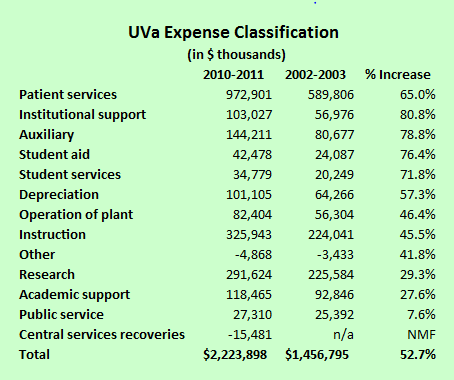About Bacon’s Rebellion
Bacon's Rebellion is Virginia's leading independent portal for news, opinions and analysis about state, regional and local public policy. Read more about us here.
Is Anyone Prepared to Tame UVa's Bureaucracy?
 by James A. Bacon
by James A. Bacon
Governor Bob McDonnell has delivered an ultimatum to the University of Virginia Board of Visitors: Get the Teresa Sullivan mess straightened out by Tuesday or he will replace the entire board. The governor, who long seemed disengaged from the controversy stemming from the forced resignation of the UVa president, now has taken ownership of it.
Given the fluidity of the situation, it’s impossible to know what outcome to expect. Will Sullivan be reappointed as president? Will Helen Dragas step down as rector? However the brouhaha is resolved at a personnel level, the fundamental issues at root of the controversy will remain.
Dragas may have mishandled procedural and public-relations aspects of the resignation in explaining her reasons for seeking Sullivan’s ouster, but she has provided the most incisive commentary yet seen on the threats facing the university. In a statement issued last week, she outlined ten main challenges, including the decline in state and federal support, the onrush of online learning, a deteriorating faculty-student ratio, declining faculty compensation compared to peer institutions, declining research rankings, drifting fund raising engagement, insufficient accountability for academic quality and productivity and a need to reallocate resources. This is meaty stuff. Anyone who dismisses Dragas as a politically appointed dilettante needs to read the statement.
The underlying problem is that UVa, like other public universities, is trying to do too much. Even as government support has declined over the years, the university has increased its ambitions. Yet the system continually has funneled more of its resources into administration rather than the areas of greatest concern.
Peruse the April 2002 “Virginia 2020 Priorities Report to the Board of Visitors,” which provides an overview of the strategic plan put into place a decade ago under Sullivan’s predecessor, John Casteen. Priorities included beefing up the fine and performing arts, building science and technology programs, extending the international reach of student and faculty programs, pumping up public service and outreach, improving the quality of student life and providing more generous financial support to graduate students.
To achieve those goals, the university needed more money. The gap between the university’s lofty ambitions and the means to achieve them reached a crisis point on Sullivan’s watch. Recession-battered alumni were not giving as much, the public was revolting against higher tuition and fees, and state government was cutting its commitment to higher education. The obvious alternative to raising more money — cutting expenses — does not appear to have stimulated much serious discussion. The notion of boosting faculty productivity and/or reducing administrative overhead simply are not a part of the academic thought process. Antipathy to “corporate-style restructuring” runs deep in the academic culture.
Yet UVA clearly needs to re-think priorities. Let’s look at the numbers, starting with the 2002/03 academic year (when the UVa annual president’s report began publishing functional data in a format that can be compared with all subsequent years) and ending with 2011/12 (the most recent year for which data is available).
Declining productivity. Full-time-equivalent (FTE) student enrollment increased 5.4% over that nine-year period. Yet the number of FTE employees increased 8.5%. That is all the more remarkable, considering that Dragas has bemoaned a declining faculty-student ratio. The numbers imply an increase in administrative overhead, expansion in non-core activities, an erosion in faculty productivity or a combination of all three.
Rising compensation. While university leaders insist that the relative compensation of UVa faculty compared to peers is falling, that’s not for a lack of pay raises at UVa. In the 2002/03 year, the average compensation per FTE was $73,300. By the 2010/11 year, average compensation had increased to $101,700. Compare that to inflation and the increase in average U.S. wages:
UVa compensation per FTE: +38.7%
National average wage: +25.3%
Consumer Price Index (2002-2010): 21.2%
(Note: Compensation includes wages plus benefits, so the numbers are not exactly comparable. However, comparing percentage increases suggest that the upward momentum for UVa compensation greatly exceeded that for average U.S. wages over the past decade.)
Administrative bloat. Sullivan has decried the fact that UVa faculty are subject to raids from other universities that can afford to pay them more. In her recent missive, Dragas noted a decline of UVa faculty compensation from 26th to 36th since 2005 among Association of American University peers. The implication is that the university is starved of resources. Is it? Or is the problem that the resources are poorly distributed? Consider the expense data below, which show expenditure increases over a nine-year period.

Ignoring the cost of “patient services,” which derive from the UVa health system, the strongest academic growth area was “institutional support,” which the university defines as “activities whose primary purpose is to provide operational support for the day-to-day functioning of the institution, excluding expenditures for physical plant operations. This is primarily expenditures related to central administrative offices.” In other words, administrative overhead.
“Auxiliary enterprises” comprised the next big growth category, adding $64 million in spending, for a 79% growth rate. This covers everything from student dining and housing to student activities, parking and intercollegiate athletics. Roughly two-thirds of the growth is accounted for by a 170% growth in the athletics budget, reflecting growing revenues from television contracts and other sources.
“Student aid” comes next. Of the major growth categories, this is the only one directly benefiting students. The university boosted scholarships and other financial support by 76.4% to offset increased tuition and fees that more than doubled.
“Student services” encompass activities whose primary purpose is to "contribute to the students’ emotional and physical well-being and to their intellectual, cultural, and social development outside of the classroom.” This covers everything from student health and intramural sports to fraternity & sorority life and diversity programs. More bureaucracy. This category increased 71.8%.
Interestingly, the core categories upon which the university’s reputation is based all drew the short straws. Despite an increasing student body, instruction increased only 45.5%. Spending on faculty compensation rose only 33.4%. Academic support, which covers libraries, IT and the activities of the deans, barely matched the inflation rate.
The one category to show real (inflation-adjusted) spending cuts was public service.
It is difficult to view these numbers and avoid the conclusion that there were ample funds to increase funding for faculty salaries, research and financial aid. But instead of funding core priorities, the money flowed to administrative overhead. The bureaucracy has taken over. Whoever winds up UVa’s next president and who serves on the Board of Visitors, they will have to grapple with the challenge of reallocating tens of millions of dollars to where the money is really needed. As Dragas as rightfully observed, incremental change just won’t cut it.

